
Salisbury is a cathedral city and civil parish in Wiltshire, England with a population of 41,820, at the confluence of the rivers Avon, Nadder and Bourne. The city is approximately 20 miles from Southampton and 30 miles from Bath.

Salisbury Cathedral, formally the Cathedral Church of the Blessed Virgin Mary, is an Anglican cathedral in the city of Salisbury, England. The cathedral is considered the beau idéal of Early English Gothic design. Built over a relatively short period, some 38 years between 1220 and 1258, it has a unity and coherence that is unusual in medieval English cathedrals. The tower and spire were completed by 1330 and at 404 feet (123 m) is the tallest church spire in England.

William Butterfield was a British Gothic Revival architect and associated with the Oxford Movement. He is noted for his use of polychromy.
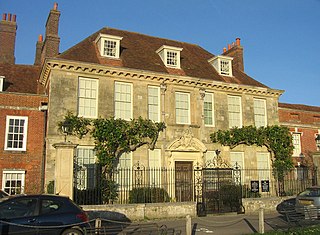
Mompesson House is an 18th-century house in the Cathedral Close, Salisbury, Wiltshire, England. The house is Grade I listed and has been in the ownership of the National Trust since 1975.
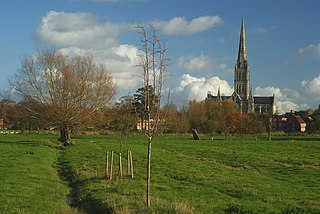
Harnham is a suburb of the city of Salisbury in Wiltshire, England, centred about 0.6 miles (1 km) south of Salisbury Cathedral and across the River Avon. Harnham is split into the areas of West Harnham and East Harnham.

Britford is a village and civil parish beside the River Avon about 1.5 miles (2.4 km) south-east of Salisbury in Wiltshire, England. The village is just off the A338 Salisbury-Bournemouth road. The 2011 Census recorded a parish population of 592.
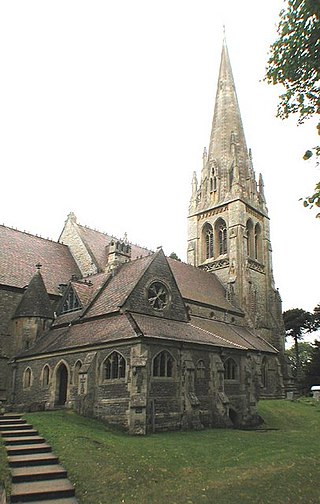
Henry Woodyer (1816–1896) was an English architect, a pupil of William Butterfield and a disciple of A. W. N. Pugin and the Ecclesiologists.
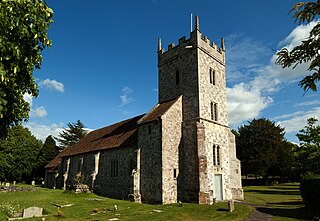
St Lawrence's Church at Stratford-sub-Castle is a 13th-century Grade I listed Church of England parish church, to the north of Salisbury, Wiltshire, England. It stands close to the abandoned settlement of Old Sarum and the River Avon, and is about 2 miles (3.2 km) north of Salisbury Cathedral.

The Church of the Holy Cross is the Grade I listed Anglican parish church in the village of Sherston, Wiltshire, England. It has Norman origins and contains many interesting religious items, including remains of Norman wall decoration, and a crucifix donated to the church by Italian soldiers during World War II.
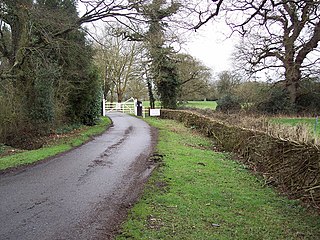
Clarendon Park is a Grade I listed building, estate and civil parish located a short distance east of the city of Salisbury in Wiltshire, England. According to the 2011 census the population of the parish was 246.

Netherhampton is a village and civil parish in Wiltshire, England, immediately west of the city of Salisbury. The village is about 2 miles (3.2 km) from the city centre.
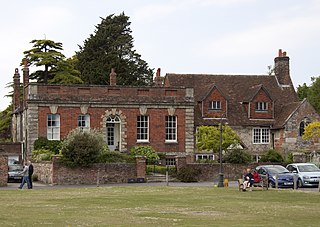
Hemingsby House is a Grade I listed, 14th-century house in Salisbury, England, in the north-west corner of Salisbury Cathedral Close, overlooking Choristers' Green.

Compton Park House is a Grade I listed manor house in Compton Chamberlayne, Wiltshire, England, about 7 miles (11 km) east of Salisbury.

The Pepperbox, also known as Eyre's Folly, is a folly tower that stands near the highest point on Pepperbox Hill, the peak of a chalk ridge about 5 miles (8 km) south-east of the city of Salisbury, Wiltshire, England. Built in 1606 by Giles Eyre, the folly is a three-storey hexagonal tower constructed of brick, with its entrances and windows blocked up. The building's original purpose is unknown, though theories include that it was built to provide Eyre with views of Longford Castle or to provide local landowners' wives, including Eyre's wife Jane, with a lookout tower to watch the hunt. The tower is considered one of the oldest follies, and is a Grade II listed building. The tower and hillside are owned by the National Trust.
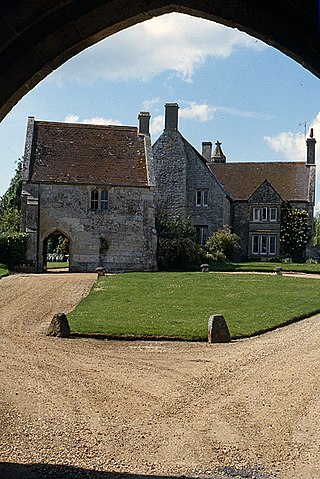
Place Farm is a complex of medieval buildings in the village of Tisbury, Wiltshire, England. They originally formed a grange of Shaftesbury Abbey. The farmhouse, the inner and outer gatehouses and the barn, reputedly the largest in England, are all Grade I listed buildings.

John Halle's Hall is a 15th-century late medieval building, a hall house, in Salisbury, England, with later 16th-, 19th- and 20th-century additions. The Hall is a Grade I listed building, the top category, 'of highest significance'. The medieval part of the building is now the foyer of a cinema, with a Victorian mock-Tudor street façade added in 1880–1881, together with the main cinema screening room built in 1931 behind the foyer. The noted architectural historian Sir Nikolaus Pevsner described this conglomeration as ' ... a great curiosity, a cinema with a grossly overdone timber-framed Tudor façade ..., and behind this façade the substantial and memorable remains of the House of John Hall'.

St Osmund's Church is a Roman Catholic church in Salisbury, Wiltshire, England. It was designed by Augustus Pugin in the Gothic Revival style and built in 1847–1848. It is on Exeter Street, opposite Bishop Wordsworth's School, in the city centre. It is a Grade II listed building.

Myles Place, No. 68 The Close, Salisbury, Wiltshire, England is a former canonry, now a private home in the close of Salisbury Cathedral. The earliest known building on the site was a medieval residence for members of the cathedral clergy. The house was rebuilt in 1720. Considered the "stateliest house in the close", it is a Grade I listed building.

Harnham Gate, Salisbury is an 1821 landscape painting by the British artist John Constable. It depicts a view of the medieval Harnham Gate, at the southern end of the cathedral close in the Southern English cathedral city of Salisbury; the gate connects the city with the southern suburb of Harnham. The gateway is seen from the western side looking eastwards, with the spire of Salisbury Cathedral visible in the distance. Constable was a frequent visitor to Salisbury, where his patron John Fisher was bishop, and he painted numerous views of the cathedral. He stayed in the city in 1820 and again in 1821.

Malmesbury House is a Grade I listed building in Salisbury, Wiltshire, England, in the city's cathedral close. Located on the eastern side of the close by the St Anne's Gate, it is one of numerous historic buildings in the city. It was constructed in 1416 during the late medieval era and replaced an earlier house demolished in 1399. It was known in its early years as Copt Hall, and had substantial additions made during following centuries notably in Queen Anne's reign. A plaque commemorates the three Protestant martyrs who were executed in Salisbury in 1556.






















